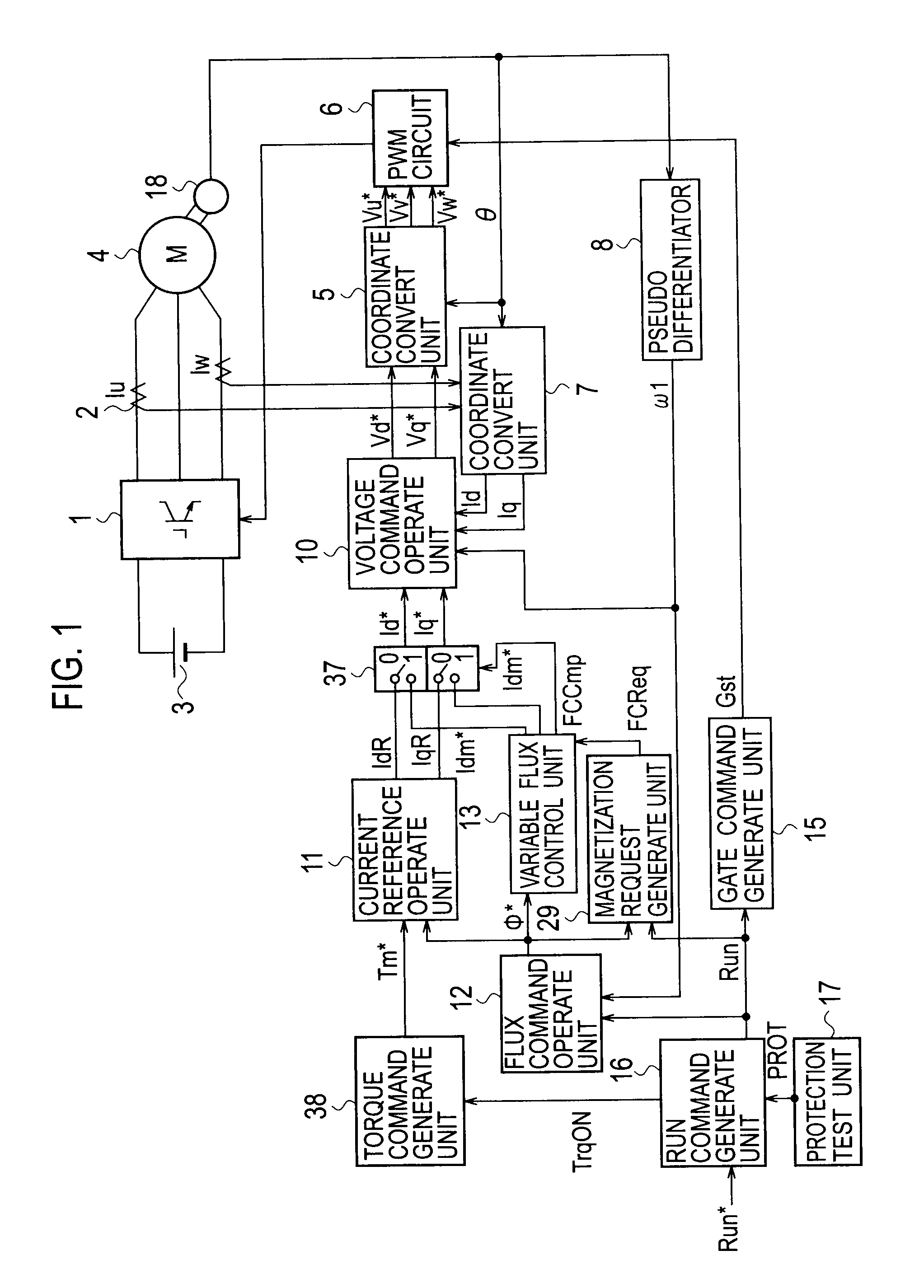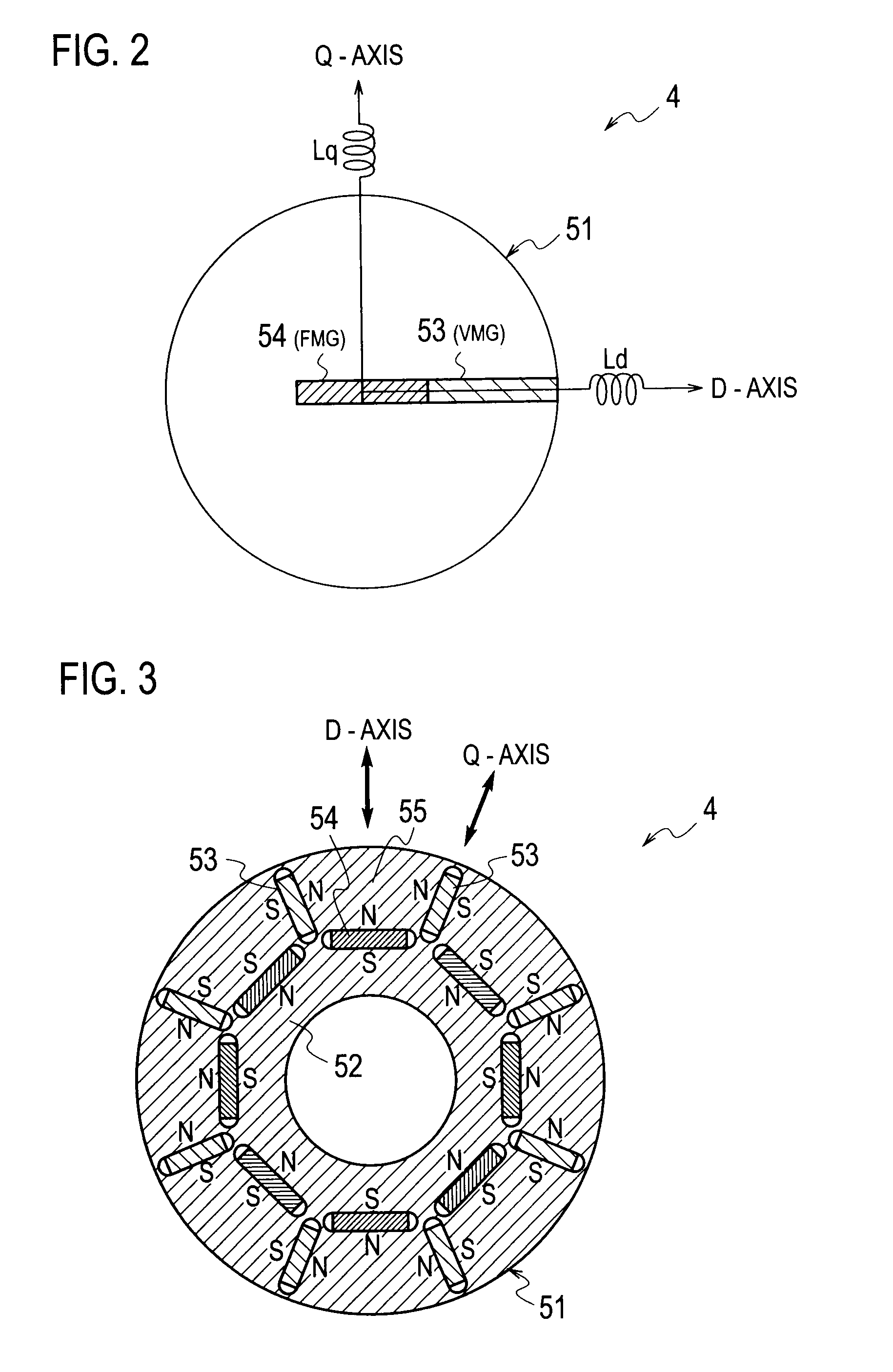Variable-flux motor drive system
a technology of variable-speed motors and drive systems, applied in the direction of motor/generator/converter stoppers, dynamo-electric converter control, transportation and packaging, etc., can solve the problems of high heat loss of pm motors at low speed, field-weakening control must be carried out, and the efficiency of superposed excitation currents deteriorate, so as to prevent a braking force from being applied and protect the system. the effect of safety
- Summary
- Abstract
- Description
- Claims
- Application Information
AI Technical Summary
Benefits of technology
Problems solved by technology
Method used
Image
Examples
first embodiment
[0097]FIG. 1 is a block diagram showing a variable-flux motor drive system according to the first embodiment of the present invention. First, a main circuit including a variable-flux motor 4 of the drive system will be explained. An inverter 1 inverts DC power from a DC power source into AC power, which is supplied to the variable-flux motor 4. Currents Iu and Iw supplied to the variable-flux motor 4 are detected by a current detector 2 and are converted by a coordinate convert unit 7 into a D-axis current Id and a Q-axis current Iq, which are input to a voltage command operate unit 10. The voltage command operate unit 10 outputs a D-axis voltage command Vd* and a Q-axis voltage command Vq* to a coordinate convert unit 5, which converts them into three-phase voltage commands Vu*, Vv*, and Vw* to be input to a PWM circuit 6. The PWM circuit 6 controls ON / OFF of switching elements of the inverter 1 according to a gate command Gst from a gate command generate unit 15. A rotational angl...
second embodiment
[0167]FIG. 10 is a block diagram showing a variable-flux motor drive system according to the second embodiment of the present invention. The second embodiment differs from the first embodiment shown in FIG. 1 in that a magnetization request generate unit 29 generates a preliminary magnetization request flag FCReq0 to be supplied to a torque command generate unit 38 instead of the magnetization request flag FCReq to be supplied to the variable flux control unit 13 and that the torque command generate unit 38 receives, in addition to a torque permission flag TrqON, the preliminary magnetization request flag FCReq0 and a magnetization completion flag FCCmp and generates, in addition to a torque command Tm*, a magnetization request flag FCReq. Namely, the torque command generate unit 38 prepares the torque command Tm* to reduce torque when magnetizing a variable magnet, and after reducing torque, provides the variable flux control unit 13 with the magnetization request flag FCReq. Accor...
third embodiment
[0177]FIG. 13 is a block diagram showing a variable-flux motor drive system according to the third embodiment of the present invention. The third embodiment differs from the first embodiment shown in FIG. 1 in that it additionally has a modulation factor operate unit 61 and a field-weakening control unit 62, an output signal from the field-weakening control unit 62 being supplied to a magnetization request generate unit 29. As a result, the magnetization request generate unit 29 generates a magnetization request based on a modulation factor of an inverter 1. The same elements as those of FIG. 1 are represented with the same reference marks, to omit repetitive explanations.
[0178]In FIG. 13, a DC voltage Vdc of the inverter 1 is detected by a DC voltage detector 60 and is supplied to the modulation factor operate unit 61. The modulation factor operate unit 61 receives the DC voltage Vdc and D- and Q-axis voltage commands Vd* and Vq* from a voltage command operate unit 10. Based on the...
PUM
 Login to View More
Login to View More Abstract
Description
Claims
Application Information
 Login to View More
Login to View More - R&D
- Intellectual Property
- Life Sciences
- Materials
- Tech Scout
- Unparalleled Data Quality
- Higher Quality Content
- 60% Fewer Hallucinations
Browse by: Latest US Patents, China's latest patents, Technical Efficacy Thesaurus, Application Domain, Technology Topic, Popular Technical Reports.
© 2025 PatSnap. All rights reserved.Legal|Privacy policy|Modern Slavery Act Transparency Statement|Sitemap|About US| Contact US: help@patsnap.com



